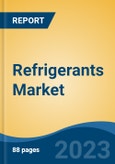Free Webex Call
The Refrigerants Market was valued at USD 6.50 Billion in 2024, and is expected to reach USD 8.64 Billion by 2030, rising at a CAGR of 4.82%. Refrigerant is a crucial mixture of fluid substances used in heat pump or refrigeration cycles, acting as a coolant. During the refrigeration cycle, it undergoes a conversion from liquid to gas. It is widely utilized due to its favorable properties, including a non-corrosive nature, high heat vaporization, moderate density in liquid form, and high density in gaseous form. Various chemicals like hydrochlorofluorocarbons (HCFC), hydrofluorocarbons (HFC), chlorofluorocarbons (CFC), and other inorganic compounds are employed as refrigerants. Speak directly to the analyst to clarify any post sales queries you may have.
10% Free customizationThis report comes with 10% free customization, enabling you to add data that meets your specific business needs.
The growth of the refrigerant market is fueled by factors such as urbanization, lifestyle improvements, and the increasing demand for air conditioners. Technological advancements, particularly in the freezing techniques used in the food and transportation industries, further contribute to market growth. Additionally, the rise in automobile production, where refrigerants are utilized for air conditioning, drives the demand for refrigerants. Furthermore, the increasing production of electric vehicles plays a significant role in energy conservation and boosts the refrigerant market.
Key Market Drivers
Growing Demand of Refrigerants in Food & Beverage Industry
Refrigerants play a crucial role in the food and beverage industry, providing the necessary cooling for food storage and transportation. They are used in various applications, including cold storage, refrigerated transport, and refrigeration equipment in retail stores. As the need for food safety and quality increases, so does the demand for effective and efficient refrigeration solutions.One of the key factors driving the demand for refrigerants in the food and beverage industry is the increase in the consumption and global trade of perishable foods. As consumers become more health-conscious, the demand for fresh, chilled, and frozen foods has risen. This trend necessitates the use of robust refrigeration systems to maintain the quality and safety of these foods. A recent study indicates that millennial consumption of frozen foods has risen by 34.7% over the past year. Additionally, 62 respondents expressed a preference for frozen vegetables and processed vegetarian foods over their fresh counterparts, highlighting a growing shift toward convenience and extended shelf life in dietary choices.
Key Market Challenges
Rising Transition to Low-GWP Alternatives
Refrigerants with high Global Warming Potential (GWP), such as hydrofluorocarbons (HFCs), have been identified as contributors to global warming due to their ability to trap heat in the atmosphere. This has prompted the need for global HFC phase-down targets and proposals. In response, the industry has started developing equipment that utilizes low-GWP alternative refrigerants, aiming to mitigate the environmental impact.Key Market Trends
Increased Adoption of Hydrofluoroolefins (HFOs)
The transition to Hydrofluoroolefins (HFOs) as refrigerants is driven by several factors. Firstly, the increasing demand for sustainable and eco-friendly refrigerants that have lower global warming potential (GWP) is pushing industries to adopt HFOs. The need to reduce greenhouse gas emissions and mitigate climate change effects has become a priority for many sectors.Key Market Players
- Daikin Industries, Ltd.
- Asahi Glass Corporation
- The Chemours Company
- Sinochem Group Co Ltd
- Honeywell International Inc.
- Gujarat Fluorochemicals Limited
- Airgas Refrigerants Inc.
- Linde PLC
- Mexichem America Inc.
- SRF Limited
Report Scope:
In this report, the Global Refrigerants Market has been segmented into the following categories, in addition to the industry trends which have also been detailed below:Refrigerants Market, By Type:
- CFCs
- HCFCs
- HFCs
- Inorganic Refrigerants
- Others
Refrigerants Market, By Application:
- Air Conditioners
- Refrigerators
- Electronics Devices
- Chillers
- Others
Refrigerants Market, By Region:
- North America
- United States
- Canada
- Mexico
- Europe
- France
- United Kingdom
- Italy
- Germany
- Spain
- Asia-Pacific
- China
- India
- Japan
- Australia
- South Korea
- South America
- Brazil
- Argentina
- Colombia
- Middle East & Africa
- South Africa
- Saudi Arabia
- UAE
Competitive Landscape
Company Profiles: Detailed analysis of the major companies present in the Global Refrigerants Market.Available Customizations:
With the given market data, the publisher offers customizations according to a company's specific needs. The following customization options are available for the report.Company Information
- Detailed analysis and profiling of additional market players (up to five).
This product will be delivered within 1-3 business days.
Table of Contents
1. Product Overview
2. Research Methodology
3. Executive Summary
5. Refrigerants Market Outlook
6. North America Refrigerants Market Outlook
7. Europe Refrigerants Market Outlook
8. Asia-Pacific Refrigerants Market Outlook
9. South America Refrigerants Market Outlook
10. Middle East and Africa Refrigerants Market Outlook
11. Market Dynamics
12. Market Trends & Developments
16. Competitive Landscape
Companies Mentioned
- Daikin Industries, Ltd.
- Asahi Glass Corporation
- The Chemours Company
- Sinochem Group Co Ltd
- Honeywell International Inc.
- Gujarat Fluorochemicals Limited
- Airgas Refrigerants Inc.
- Linde PLC
- Mexichem America Inc.
- SRF Limited
Table Information
| Report Attribute | Details |
|---|---|
| No. of Pages | 185 |
| Published | February 2025 |
| Forecast Period | 2024 - 2030 |
| Estimated Market Value ( USD | $ 6.5 Billion |
| Forecasted Market Value ( USD | $ 8.64 Billion |
| Compound Annual Growth Rate | 4.8% |
| Regions Covered | Global |
| No. of Companies Mentioned | 10 |









